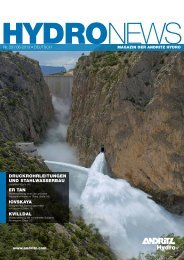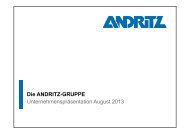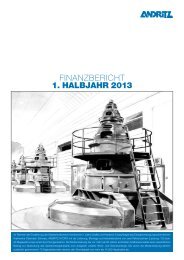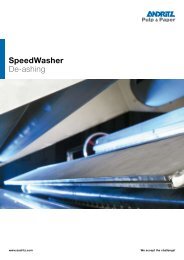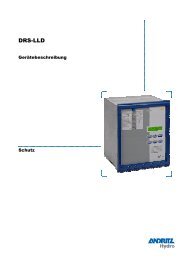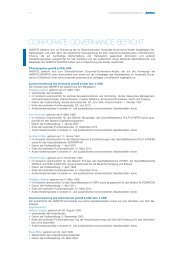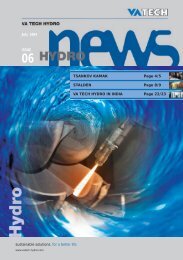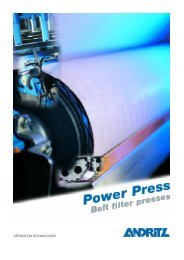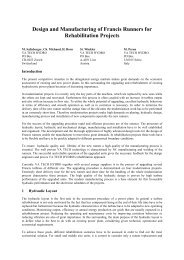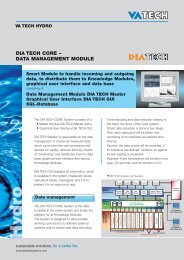FiberSpectrum - ANDRITZ Vertical volute pumps
FiberSpectrum - ANDRITZ Vertical volute pumps
FiberSpectrum - ANDRITZ Vertical volute pumps
Create successful ePaper yourself
Turn your PDF publications into a flip-book with our unique Google optimized e-Paper software.
watering and Bleaching with Andritz’s<br />
Paper Engineered Services group.<br />
“The Hylte Mill wanted to increase<br />
sludge production to about 82 t/d on<br />
each gravity table and maintain the current<br />
level of dryness (65%) after each<br />
screw press,” Salawa says. “They<br />
needed that level of dryness since<br />
they incinerate their sludge to recover<br />
energy and reduce the amount going to<br />
landfill.”<br />
Salawa noted that the existing gravity<br />
tables were equipped with beds two<br />
meters wide and six meters long, without<br />
floating rolls. “We recommended<br />
that the Hylte Mill extend the length of<br />
the inlet end of each gravity table by<br />
two meters and add a floating roll to<br />
the outlet end. This would get them the<br />
production and dryness they wanted.”<br />
“After meeting and discussing with<br />
Artur, I knew that he was the right<br />
person with the right expertise we<br />
needed,” Kurkimäki says. “There was<br />
no question in my mind about which<br />
supplier would do the best job on the<br />
rebuild. He was the key driver of this<br />
project from the outside and Andritz<br />
was the right choice.”<br />
The rebuild project<br />
Salawa gives a brief description of the<br />
gravity dewatering process: “A flocculent<br />
(polymer) is added to the sludge<br />
and the suspension stays in the headbox<br />
of the gravity table until flocs form.<br />
Then it flows onto a fast-moving wire,<br />
where the free water drains through the<br />
wire and the thickened sludge continues<br />
on the wire. The dewatering is<br />
assisted by chicanes mounted in rows<br />
so that the sludge cake is gently turned<br />
over.<br />
“For additional dryness, we installed<br />
a new floating roll at the end of the<br />
table to gently remove remaining water<br />
from the thickened sludge cake. The<br />
thickened sludge cake is removed by a<br />
spring-loaded take-off doctor and then<br />
fed to the sludge screw press. In the<br />
press, the volutions of the slowly rotating<br />
shaft press the sludge against the<br />
outlet casing. The retention time in the<br />
press is about 15 minutes.”<br />
Andritz was required to rebuild the<br />
Hylte Mill’s equipment during scheduled<br />
shutdowns, so precision planning was<br />
crucial. “Working with professionals<br />
certainly made the project achievable in<br />
a relaxed yet fast-paced atmosphere,”<br />
says Johansson.<br />
Each gravity table was extended by two<br />
meters on the inlet side. The new floating<br />
roll was installed on the outlet side<br />
and the original wire was replaced with<br />
a new longer spiral wire.<br />
The rebuild work was staged so that<br />
the DIP-line 1 was completed first.<br />
After the usual checks, the rebuilt gravity<br />
table was started up on February 2,<br />
2007. The upgraded units for sludge<br />
handling lines 2 and 3 were started up<br />
April 16, 2007.<br />
Very dry results<br />
During the performance test for Line 1<br />
in February, technicians from the Hylte<br />
Mill took samples to check the outlet<br />
Stora Enso Hylte<br />
◄ Artur Salawa from Andritz (left) talks with Tommy<br />
Johansson (center) and Mauri Kurkimäki, DIP<br />
Operating Technician, about the performance of<br />
the rebuilt sludge dewatering system.<br />
dryness of the gravity tables and the<br />
screw press. The samples were evaluated<br />
in the mill’s laboratory. Similar<br />
tests were done in April when the other<br />
two lines started up.<br />
“Our objective was fully met by<br />
Andritz,” says Kurkimäki. “The equipment<br />
was able to handle an increased<br />
flow of sludge with the same dryness<br />
as before.”<br />
“All gravity tables easily fulfill the<br />
guaranteed values of 82 admt/d sludge<br />
production at 20.0 -23.6% dryness,”<br />
Salawa says. “The highest production<br />
we measured during the performance<br />
test was 90 admt/d. This with an inlet<br />
consistency of 3.5% and an ash content<br />
of 64%. After the screw presses,<br />
the dryness increases to 65%.”<br />
The dewatering process is also using<br />
less polymer than before while achieving<br />
higher production.<br />
“Currently with the rebuild we are<br />
reaching 790 tonnes of deinked pulp<br />
per day,” Johansson says. “By Christmas,<br />
we will reach our goal of 800<br />
tonnes per day.”<br />
“Improving production and using energy<br />
in the most effective manner possible<br />
is a priority issue for us,” says Sundkvist.<br />
“It is our responsibility to utilize<br />
investment funds where they do the<br />
most good. Well-planned projects like<br />
this rebuild lead to reduced costs and<br />
provide a high return.”<br />
►► find out more at<br />
www.fiberspectrum.andritz.com<br />
▲ (From left) Artur Salawa, Mauri Kurkimäki, Sven-Åke Bertilsson, and Tommy Johansson check the<br />
performance of the gravity table. The rebuilt units are designed to handle 82 t/d of sludge at a dryness of up to<br />
23.6%.<br />
Sludge is not a dirty word.<br />
Removing the ink, clay, coatings, and<br />
contaminants from wastepaper in order<br />
to salvage reusable fibers creates<br />
deinking sludge, and deinking sludge<br />
creates disposal concerns.<br />
Wastepaper with high amounts of filler,<br />
such as clay-coated magazine paper,<br />
produces much lower yields of usable<br />
fiber than does wastepaper that is<br />
mostly cellulose fiber, such as computer<br />
printout or old newspaper. Paper<br />
that is only lightly printed will produce<br />
less sludge than paper that is heavily<br />
printed. Post-consumer papers generally<br />
produce more sludge because they<br />
tend to be more heavily contaminated.<br />
In the past, the greatest percentage of<br />
hazardous material in deinking sludge<br />
came from the inks and pigments. In<br />
recent years, however, ink manufacturers<br />
have made enormous strides in<br />
eliminating heavy metals from commercial<br />
printing inks.<br />
Along with the inks, deinking removes<br />
other non-cellulose materials from the<br />
fiber, including coatings, adhesives,<br />
dyes and fillers like calcium carbonate<br />
and clay, as well as trash like metals<br />
and plastics. All wind up in the sludge.<br />
What can be done with all that<br />
sludge?<br />
Traditionally, deinking sludge has been<br />
handled in three different ways: landfilling,<br />
incinerating, and landspreading.<br />
Landfilling is the most widely used<br />
method for disposal of deinking sludge.<br />
Before the sludge is landfilled, water is<br />
removed from it to make it about 40%<br />
solids. Some mills are permitted to use<br />
municipal landfills, but most use their<br />
own private disposal facilities.<br />
A few mills burn deinking sludge in their<br />
boilers as “hog” fuel. The high moisture<br />
of the sludge affects its ability to<br />
burn efficiently. To enhance its heating<br />
value, the sludge is sometimes mixed<br />
with dry waste material (such as wood<br />
chips). Fluidized bed combustion is<br />
one emerging technology that works<br />
particularly well with the wet sludges<br />
produced by deinking mills.<br />
Several mills landspread sludge. The<br />
sludge is spread on farmland and<br />
adds some organic matter to the soil<br />
and provides trace nutrients, including<br />
nitrogen, phosphorous, and potassium.<br />
The calcium carbonate acts as a lime<br />
substitute, which helps balance overly<br />
acidic conditions. The clay increases<br />
the soil’s capacity to hold nutrients and<br />
is particularly effective for sandy soils.<br />
Recognizing that sludge disposal is a<br />
growing concern, the paper industry is<br />
engaged in intensive research (much<br />
of it proprietary) to develop alternative<br />
uses for the material. Other applications<br />
include composting, agricultural<br />
use, cement production, brick manufacturing,<br />
furnish for fiberboard production,<br />
wet oxidation, fermentation, pyrolysis,<br />
hydrolysis, and absorbent material like<br />
cat litter.<br />
14 15



